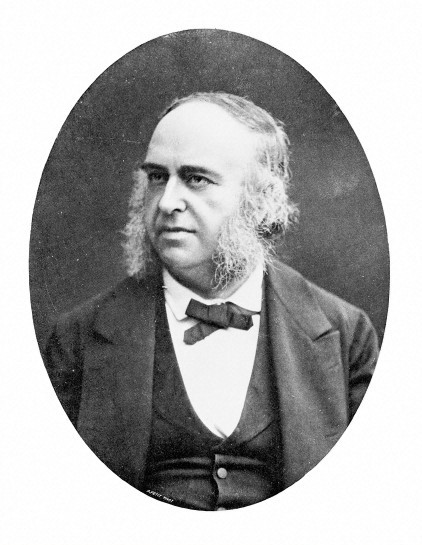<Back to Index>
- Physician and Anatomist Pierre Paul Broca, 1824
PAGE SPONSOR

Pierre Paul Broca (28 June 1824 – 9 July 1880) was a French physician, anatomist, and anthropologist. He was born in Sainte - Foy - la - Grande, Gironde. He is best known for his research on Broca's area, a region of the frontal lobe that has been named after him.
Broca's early scientific works dealt with the histology of cartilage and bone, but he also studied cancer pathology, the treatment of aneurysms, and infant mortality. One of his major concerns was the comparative anatomy of the brain. His celebrated paper refers to many animal species. As a neuroanatomist he made important contributions to the understanding of the limbic system and rhinencephalon. Olfaction was for him a sign of animality. His research on the localization of speech led to entirely new research into the lateralization of brain function. He wrote extensively on biological evolution, then known as transformism in France (the term was also adopted in English at the time but is today used little in either language).
Broca is most famous for his discovery of the speech production center of the brain located in the ventroposterior region of the frontal lobes (now known as Broca's area). He arrived at this discovery by studying the brains of aphasic patients. His first patient in the Bicêtre Hospital was Leborgne, nicknamed "Tan" due to his inability to clearly speak any words other than "tan".
In 1861, through post mortem autopsy, Broca determined that Tan had a lesion caused by syphilis in the left cerebral hemisphere. This lesion was determined to cover the area of the brain important for speech production, affecting syntactic skills of patients. (Although history credits this discovery to Broca, another French neurologist, Marc Dax, made similar observations a generation earlier.) Today the brains of many of Broca's aphasic patients are still preserved in the Musée Dupuytren, and his collection of casts in the Musée d'Anatomie Delmas - Orfila - Rouvière. Broca presented his findings on the localization of language at the 1868 British Association meeting in Norwich, chaired by Joseph Dalton Hooker, and the subsequent discussions included Hughlings Jackson.
Patients with damage to Broca's area and/or to neighboring regions of the left inferior frontal lobe are often categorized clinically as having Broca's aphasia. This type of aphasia, which often involves impairments in speech output, can be contrasted with Wernicke's aphasia, named for Karl Wernicke, which is characterized by damage to more posterior regions of the left hemisphere (in the superior temporal lobe), causing semantic disruptions within the output of speech. This is an example of a double dissociation, an important tool used by neuropsychologists to investigate brain function.
Broca was also a pioneer in the study of physical anthropology. He founded the Société d'Anthropologie de Paris in 1859, the Revue d'Anthropologie in 1872, and the School of Anthropology in Paris in 1876. Just like everybody else in his time he had no reason to think that the skulls of living people were trepanned prior to the time of the ancient Greeks. The situation changed dramatically for him in 1867, and subsequently for scientists around the world, after he was shown an old Peruvian skull with cross - hatched cuts. This skull came from an Inca cemetery in the valley of Yucay and was shown to him by Ephraim George Squier, an archaeologist, writer, and diplomat. Careful examination of the Peruvian skull left no doubt in Broca's mind that "advanced surgery" had been performed in the New World before the European conquest.
Broca advanced the science of cranial anthropometry by developing many new types of measuring instruments (craniometers) and numerical indices. The uses that reputable scientists, including racist ones, made of Broca's measurements and conclusions have been analyzed by Stephen Jay Gould in The Mismeasure of Man (1981) and by his biographer, Francis Schiller. Broca's work is also featured in Carl Sagan's book Broca's Brain.
Another field in which Broca contributed significantly was the comparative anatomy of primates. He described, for the first time, trephined skulls from the Neolithic. He was very interested in the relation between anatomical features of the brain and mental capabilities, such as intelligence.
As a personality, Broca was a remarkable individual. His biographer, neurosurgeon Francis Schiller, records his fights with his local church which attempted to have him stricken from the electoral roll. Broca was denounced by authorities as a subversive, materialist, and corrupter of the youth after he founded a society of freethinkers in 1848 sympathetic to Charles Darwin's theories.
Near the end of his life, Paul Broca was elected a lifetime member of the French Senate. He was also a member of the Académie Française and held honorary degrees from many other learned institutions, both in France and abroad. Broca died in Paris in 1880.
Broca's brain is now a specimen at the Museum of Man in Paris.
The discovery of Broca's area revolutionized the understanding of speech production. New research has found that dysfunction in the area may lead to other speech disorders such as stuttering and apraxia of speech. Recent anatomical neuroimaging studies have shown that the pars opercularis of Broca's area is anatomically smaller in individuals who stutter whereas the pars triangularis appears to be normal.